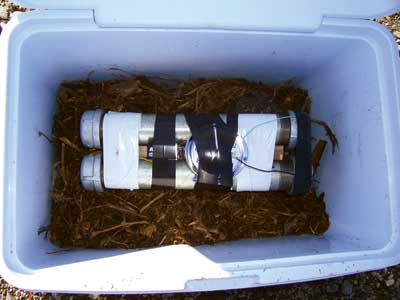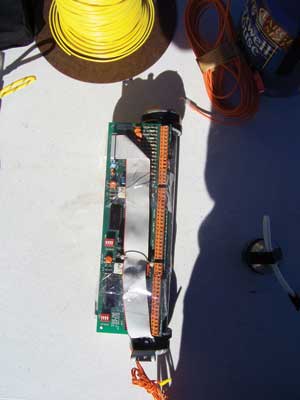BY AUGUST VERNON
Improvised explosive device (IED) and homemade explosive (HME) attacks can consist of anything from homemade pipe bombs to sophisticated military ordnance; however, emergency service agencies are more likely to encounter IEDs/HMEs than military weapons in their day-to-day responses. Terrorists around the globe prefer explosives for several reasons, as the recent explosives incidents in Norway, Pakistan, Iraq, and Afghanistan have shown. The Federal Bureau of Investigation’s annual report on terrorism shows that explosive incidents constitute the majority of domestic terrorism attacks in the United States. Public safety agencies at all levels (local, regional, state, military, and federal) must learn to work together to deter IED attacks in their jurisdictions and to safely respond if an attack occurs. Understanding some basic information, such as indicators and tactics, may help first responders prevent the initial attack and protect themselves and the public from secondary attacks.
This article provides some easy-to-follow procedures and guidelines to assist responders and incident commanders in their planning and training efforts. The information presented in this article should not replace common sense and experience. It is impossible to plan for every situation that may occur. New intelligence, “best practices,” lesson learned, and training become available on an ongoing basis. Update these plans on a regular basis.
HOMEMADE/IMPROVISED EXPLOSIVE MATERIALS
Improvised explosive materials are typically made by combining an oxidizer with a fuel. Many of these materials are fairly simple to make, requiring very little technical expertise or specialized equipment. Instructions on how to make them are provided on the Internet and in written resources such as The Anarchist Cookbook. However, recipes for homemade explosives are often inaccurate and dangerous to follow. Even accurate recipes are extremely dangerous, and the explosive materials created are often highly unstable. More than one would-be explosives maker has been killed or injured attempting to make these materials. These clandestine locations can be a fire and explosive hazard when discovered.
 |
| (1) IEDs can be found in several different sizes, kinds, and types. (Photos by author.) |
Recipes for making nitroglycerin, mercury fulminate, blasting gelatin, dynamite, TNT, tetryl, picric acid, black powder, and smokeless powder are readily available. Picric acid, nitrogen trichloride, and nitrogen tri-iodide are not marketed as commercial explosives, but they are used in laboratories and in other industrial uses. They are potentially very unstable and could be used for criminal purposes. The attacker in the Oslo, Norway, car bombing was reported to have used a 2,100-pound device using fertilizer that was built at the bomber’s farm.
PEROXIDE-BASED EXPLOSIVES
Peroxide-based explosives such as triacetonetriperoxide (TATP), hexamethylene triperoxide diamine (HMTD), and methyl ethyl ketone peroxide (MEKP) are growing concerns and threats. TATP has been frequently used by Middle Eastern terrorists to produce devices for suicide bombers’ belts, and it has been used in several recent terrorist attacks globally, including the 2005 London mass transit suicide bombings. Peroxide-based explosives can be made by mixing concentrated hydrogen peroxide (an oxidizer) with a fuel, such as acetone or ethanol, along with a strong acid. Different recipes vary the fuel and concentration of peroxide to create a range of explosives. Both TATP and HMTD are very dangerous to make and handle because they are very unstable. Both can be made in illicit laboratories located almost anywhere since highly specialized equipment is not needed for the manufacturing process. TATP is typically found in crystal form while HMTD is usually a powder; however, peroxide explosives can be in liquid form as well.
HME Information Sources
 |
| (2) Some of the reference materials that may be found in a clandestine explosives lab. |
Information on the construction and deployment of HMEs is readily available to the public. Many of the different methods of explosives attacks are described in detail in the al-Qaeda and Jihad training manuals and videos. Several specialty publishers produce books that show how to build devices using improvised materials and commercial products. Military field manuals have also been used as sources of information and can be purchased at yard sales and online. All these sources of information are also easily found on the Internet and are readily available to anyone with an interest.
Explosives Labs
Some explosive labs do not need to heat or cook any of their materials and, therefore, may lack the glassware, tubing, Bunsen burners, chemical bottles, and other paraphernalia traditionally associated with the term laboratory. However, a lab established to make explosive chemical mixtures might look more like a traditional industrial or university chemistry lab, and labs used to make TATP, HMTD, or other peroxide-based explosives might look much like a meth or drug lab.
They can be mistaken for clandestine drug labs because of the presence of household chemicals. Some improvised explosive materials can also be mistaken for narcotics. These labs can be discovered anywhere, since they do not require a lot of equipment or resources. Recipes are very easy to find on the Internet and in anarchist literature, terrorist materials, and other sources. Common explosives materials such as black powder, gunpowder, or smokeless powder can be easily incorporated into an IED. Some improvised explosive materials such as TATP and HMTD require a clandestine production lab to create. The materials needed to produce these two dangerous explosives can be found in hardware and drug stores. The basic ingredients are a fuel and an oxidizer.
Use caution. Peroxide-based explosives are extremely sensitive to heat, shock, and friction. Some indicators of a possible explosives lab can include the following:
- Refrigerator/coolers/ice baths.
- Glassware and laboratory equipment.
- Blenders.
- Blasting caps/batteries/fuses/switches.
- Pipes/end caps/storage containers.
- Shrapnel-type materials.
- Strong acidic odors.
- Hot plates.
Some of the common ingredients that may be found in a TATP/HMTD lab include the following:
- Acetones.
- Hydrogen peroxide.
- Strong or weak acids.
Once the materials are produced, they can be incorporated into a variety of IEDs. If a material is being transported using a cooling method (such as ice in a cooler), treat it with caution, as this is a favorite method of transporting raw materials. All types of clandestine labs are dangerous. Responders should be able to safely identify them and take the appropriate safety measures. If mishandled, the materials in an explosives lab can pose a significant danger.
Other clues to the presence of an explosives lab might include literature on how to make bombs, significant quantities of fireworks, hundreds of matchbooks or flares, ammunition like shotgun shells, black powder, smokeless powder, blasting caps, commercial explosives, incendiary materials, or other chemicals on the Bureau of Alcohol, Tobacco, Firearms, and Explosives (ATF) explosive materials list. Finding these items in conjunction with components that can be used to make IEDs (pipes, activation devices, propane containers, and the like) would give even more evidence of an explosives lab. Also, electronic components such as wires, circuit boards, batteries, cellular phones, and other items can point toward the possible design of an IED.
Responders must use extreme caution inside any type of clandestine laboratory. Do not attempt to approach, move, handle, or disarm a confirmed or suspected IED or HME. This is a job for specially trained and equipped personnel.
IED IDENTIFICATION
Responders must also be able to recognize a possible explosives material, an IED, or a booby trap. An IED can be discovered during a terrorist or criminal explosives incident response or when conducting routine public safety investigative or response activities. IEDs can be designed to be concealed or look like ordinary items. Be very cautious of any items that arouse your curiosity, and remember that the exterior inspection of a suspected device does not ensure its safety. Be especially wary of the following:
- Unusual devices or containers with electronic components such as wires, circuit boards, cellular phones, antennas, and other items attached or exposed.
- Devices containing quantities of fuses, fireworks, match heads, black powder, smokeless powder, incendiary materials, and other unusual materials or liquids.
- Materials attached to an item such as nails, bolts, drill bits, marbles, and so on that could be used for shrapnel.
- Ordnance such as blasting caps, detcord, military explosives, commercial explosives, grenades, and the like.
- Any combination of the above described items!
ON-SCENE ACTIVITIES
A first responder who comes across a suspicious material/item during routine activities or tactical operations should immediately inform all personnel and leave the area. Do not use your radio, cell phone, or mobile computer terminal until you are a safe distance (at least 300 feet minimum) from the material or item, depending on location and terrain.
 |
| (3) IEDs may consist of some type of electronic materials, circuit boards, wires, cell phones, and timers. |
If you find yourself next to a possible suspicious materials/item, take these steps:
- Call out to other response personnel to stop moving.
- Stop and look around for any other devices or suspicious items.
- DO not touch or move anything.
- DO not operate light, power, or electrical switches.
- Keep other responders from coming over to look or take photos.
- Do not approach or handle the suspected device/materials once they have been identified as a risk.
- Move out of the area the same way you entered by retracing your steps.
- Conduct personnel accountability reports outside the danger area.
- Isolate and secure the area.
- Establish zones of control (Hot, Warm, and Cold).
- Shield yourself, other responders, and the public.
- Call and wait for the local or state bomb squad/hazardous device unit.
- Notify other proper authorities, depending on the jurisdiction and situation.
The best and most effective defense is to be aware of your surroundings. Based on your threat, if you think the object does not belong in your area, consider it suspicious.
SCENE MANAGEMENT
Immediately implement the incident command system and unified command for these events. The response to an IED, an HME, an anti-personnel device, or a booby trap is very similar to that for a hazardous materials response. Use your “zones of control” to assist in your response efforts: Hot zone (where the device is located), Warm zone (where the perimeter will be established), and Cold zone (secured location of unified command post and staging). Notify all appropriate agencies (fire, emergency medical services, law enforcement, bomb squad, emergency management office, and hospitals) as soon as possible if there is a report of an incident or a possible threat. Resist the temptation to look at or take pictures of a confirmed or suspected IED.
SECONDARY DEVICES
If explosives devices or materials are discovered during a response or an illicit lab operation, be prepared for the presence of a secondary device or threats. Be aware of your surroundings, and search the critical areas such as the locations of the command post and staging area. In the Middle East and Far East, there have been multiple incidents in which secondary devices were left for first responders. In the United States, there have been several cases of secondary devices having been planted.
PLANNING AND TRAINING
Preparation is the key to mitigating an IED incident; that includes having a clear idea of your actions before the incident occurs. This should at least include an awareness of the hazards associated with IEDs and the proper steps for the responders to take on the discovery of an item or response to an incident. If there is a local bomb squad or a hazardous devices unit in your area, ask it to help you train and plan. Most bomb technicians will be glad to provide your agency with training on their procedures and equipment, since they will require your support during an incident.
Responders should understand their roles and responsibilities in supporting bomb squads during these incidents and how to safely treat an injured bomb tech and remove the bomb tech’s suit and equipment in case of injury. An excellent training resource is the Incident Response to Terrorist Bombings course in Soccoro, New Mexico, funded through the U.S. Department of Homeland Security. This course provides information regarding planning for and responding to IED and terrorist events. Students will witness live explosive events ranging from a small pipe bomb to a large car bomb. Students will be able to provide awareness-level training for their agencies. For additional information, see www.emrtc.nmt.edu/training.
AUGUST VERNON is the operations officer for the Forsyth County (NC) Office of Emergency Management. He returned to his position at emergency management in 2005 after a year in Iraq as a security contractor. He has been employed in this field for more than 10 years, has served in the fire service and as a fire service instructor, and also has served in the U.S. Army as a CBRN (chemical, biological, radiological and nuclear) operations specialist. Vernon has given more than 140 multiagency presentations over the past 11 years and instructs in incident command, mass violence, crisis management, emergency management, and terrorism planning response. He is a member of the IFSTA WMD/Terrorism Committee. Since 2004, he has been a technical reviewer for Emergency Film Group. Vernon provides critical incident and crisis management planning and training at the local, regional, state, and federal levels. He is the author of the First Responders Critical Incident Guide (Red Hat Publishing).
More Fire Engineering Issue Articles
Fire Engineering Archives

